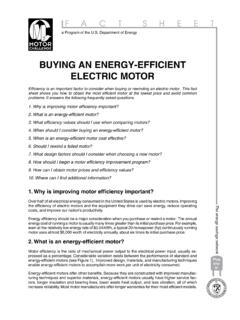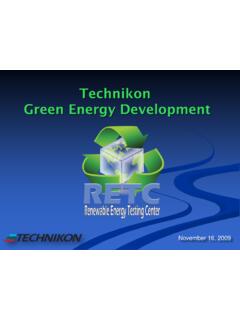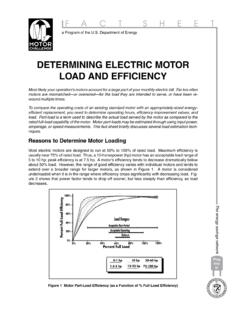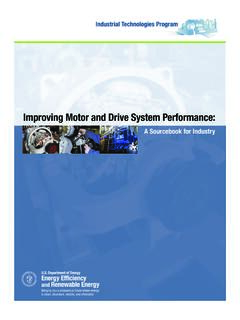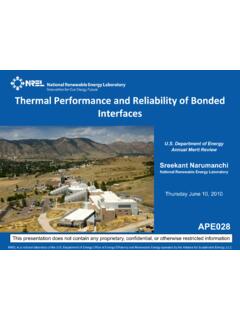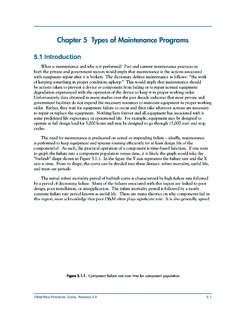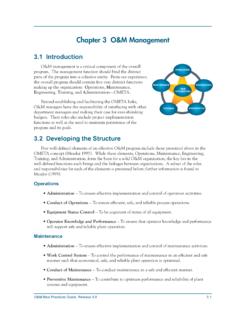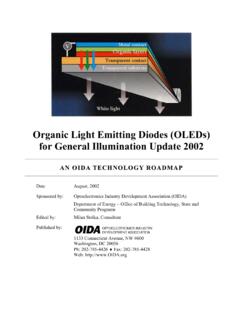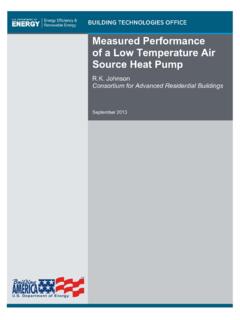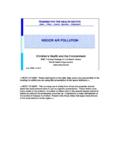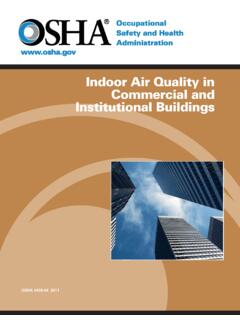Transcription of 3.0 The Social Benefits of Sustainable Design - Energy
1 The Social Benefits of Sustainable Design The Social Benefits of Sustainable Design are related to improvements in the quality of life, health , and well-being. These Benefits can be realized at different levels buildings, the community, and society in general. At a building level, research on the human Benefits of sus tainable Design has centered on three primary topics: health , comfort, and satisfaction. Although these outcomes are clearly interrelated, they have different scholarly roots and employ different methodologies. health issues are the domain of epidemiologists and public health professionals. Comfort is studied by researchers with expertise in building science and physiology, while well-being and psychosocial processes are studied by environmental and experimental psychologists. The research described in this section integrates findings from these diverse areas, with a focus on studies that assess the health , comfort, and well being outcomes associated with the presence or absence of Sustainable building components.
2 The building environment can have both negative and positive impacts on the occupants' quality of life. Negative impacts include illness, absenteeism, fatigue, discomfort, stress, and distractions resulting from poor indoor air quality , thermal conditioning, lighting, and specific aspects of interior space Design ( , materials selections, furnishings, and personnel densities). Reducing these problems through Sustainable Design often improves health and performance. Improved indoor air quality and increased personal control of temperatures and ventilation have strong positive effects. In addition to reducing risks and discomforts, buildings should also contain features and attributes that create positive psychological and Social experiences. Although less research has been done on health -promoting environments, emerging evidence shows that certain Sustainable building features, including increased personal control over indoor environmental conditions, access to daylight and views, and connection to nature, are likely to generate positive states of well- being and health .
3 Another emerging Social issue affecting buildings is security. Since September 11, 2001, Federal agencies have experienced heightened concern about how a building's features affect its ability to thwart or withstand hostile actions. The relationships between Sustainable Design and building security are important topics that will be discussed in this section. At a community or societal level, the Social Benefits of Sustainable Design include knowledge transfer, improved environmental quality , neighborhood restoration, and reduced health risks from pollutants associated with building Energy use. Although more research has been conducted on the Benefits of Sustainable Design features to building occupants, interest is growing in the community Benefits of Sustainable Design , and several potential areas of value to the Federal government are discussed at the end of this section.
4 The first two sections below describe research results indicating positive impacts of Sustainable buildings on occupant health (Section ) and comfort, satisfaction, and well-being (Section ). (Appendix F discusses these topics in more detail.) Section describes the potential Benefits of Energy efficiency and other Sustainable Design features to occupant safety and security. Section describes potential positive community impacts. Better health of Building Occupants Studies of the health Benefits of Sustainable Design focus primarily on indoor environmental quality , especially air quality . health effects result from environmental stimuli interacting with the 3-1 body s physical systems, especially respiratory, skin, neural, and visual pathways. Illness symptoms occur because environmental agents (such as chemicals or airborne microbials) affect the operation of the body s physi cal systems in vulnerable persons.
5 Many studies have found high levels of air- quality problems and occupant illnesses in office buildings ( , Brightman and Moss 2001). Studies have begun to assess the causal relationships between the building environment and illness symptoms in three areas: (1) sick building syndrome (SBS), (2) asthma and allergies, and (3) communicable and respiratory diseases (Fisk 2001). Research Summary 3-1 shows an example of such a study. The findings of this research show that the three types of illnesses are affected by different components of the environment: Sick building syndrome. SBS symptoms include headache; fatigue; dizziness; irritations of the skin, eyes, and nose; and difficulty breathing. A large review study of the links between health , perceived air quality , absenteeism, and ventilation found that ventilation rates lower than 10 L/s per person were associated with statisticall y significant worsening of symptoms in a range of building Increases in ventilation rate above 10 L/s up to 20 L/s per person were associated with decreased symptoms and improvements in perceived air quality .
6 A ventilation increase of 5 L/s per person could reduce the proportion of workers with these respiratory symptoms from 26% to 16% and those with eye irritations from 22% to 14% (Seppanen et al. 1999). SBS symptoms are also reduced by personal control over thermal conditions (Preller et al. 1990; Hedge et al. 1993), improvements in ventilation system maintenance and cleaning, reduced use of pesticides, and daily vacuuming (Sieber et al. 1996). Allergy and asthma symptoms. Several building factors moisture problems, molds, and dust mites are strongly associated with asthma and allergy symptoms (Fisk 2002). Reducing the concentrations of allergens and irritants reduces symptoms. Successful strategies for reducing such concentrations include improving HVAC maintenance and cleaning and using building practices that reduce moisture buildup (Sieber et al. 1996).
7 Other strategies include air filtration, humidity control, and elimination of indoor smoking. Asthma symptoms were found to more likely occur in the presence of new drywall and in building interiors with cloth partitions (Sieber et al. 1996). Transmission of infectious diseases. Infectious diseases can be transmitted by airborne microbes (viruses, bacteria). Airborne transmissions can be reduced significantly through ultraviolet irradiation of air near the ceiling, improved ventilation , and reduced crowding (Fisk 2000b; Seppanen et al. 1999). One study found that workers with one or more officemates were 20% more likely to have two colds during the year than workers who did not share an office (Jakkola and Heinonen 1993). Studies showing reduced risk with lower crowding do not identify what level of density is desirable for health reasons. health problems can be linked to absenteeism.
8 A study of absenteeism among office workers in a large East Coast company found that the absenteeism rate was 35% lower in offices with higher 44 ventilation and air circulation are important, but sometimes overlooked, features of Sustainable buildings. ventilation refers to the air exchange between the outside and the inside of the building. Circulation refers to the air movement within and between the interior spaces of the building. Both ventilation and circulation can be achieved through mechanical means ( , fans within air ducts) or by utilizing natural principles ( , warm air naturally rises). In either case, a well-designed system should provide sufficient ventilation to dilute contaminants generated within the building space (by either building components or occupants) as well as adequate air circulation within and between building spaces to disperse built-up air contaminants locally while not adversely affecting the occupants perception of temperature ( , creating drafts).
9 It is particularly important that measures to increase Energy efficiency by tightening up a building take into consi deration the need to maintain adequate ventilation rates. Good ventilation and Energy efficiency can be achieved simultaneously by using Sustainable building measures such as heat recovery devices. 3-2 ventilation rates (about 24 L/s per person) compared with moderate rates of 12 L/s ((Milton et al. 2000). The use of humidification and complaints about air quality were also associated with increased sick leave. The study analyzed sick leave of 3720 hourly workers in 40 buildings. The study controlled for gender, age, seniority, hours of nonillness absence, shift, ethnicity, crowding, and type of job. (See Section for additional information about absenteeism.) 2 Researchers conducted a critical review and synthesis of research on the associations between ventilation rates and occupant health to provide a scientific basis for setting health -related ventilation standards.)
10 The review shows that illness symptoms are often associated with low ventilation rates, high CO2 concentrations, and perceptions of poor air quality . Research Team: The research team included Seppanen from Helsinki University of Technology, Fisk from Lawrence Berkeley National Laboratory, and Mendell from the National Institute for Occupational Safety and health . Methodology: Both cross-sectional and experimental studies were reviewed. The following criteria were used for including cross-sectional studies: The study included at least three buildings or ventilation zones. Results were statistically analyzed and included controls for other factors that can influence health outcomes. The following criteria were used for including experimental studies: No changes occurred in the air-handling system, and occupants did not move to a different building. A control group or multiple applications of experimental conditions were used.
